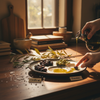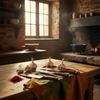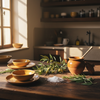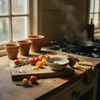How to Saute: 5 Essential Techniques for Perfect Results
The Art of the Sauté: Mastering the Technique That Makes Food Dance
There's something magical about that sizzle when ingredients hit a hot pan. That sound? It's the beginning of culinary alchemy—where raw becomes transformed, flavors intensify, and ordinary ingredients become extraordinary meals. Welcome to the world of sautéing, the cooking technique that separates the "I can follow a recipe" cook from the "watch me create something amazing" home chef.
At DI ORO, we believe mastering how to sauté isn't just about following instructions—it's about embracing the rhythm and intuition that makes cooking an art form. Whether you're tackling a weeknight dinner or impressing weekend guests, this technique is your secret weapon for dishes that look and taste like they came from a professional kitchen.
Ready to elevate your cooking game? Let's dive into the fundamentals of sautéing that will transform your kitchen confidence forever.
What is Sautéing? More Than Just Cooking in a Pan

The word "sauté" comes from the French "sauter," meaning "to jump"—a perfect description for how food moves in a properly heated pan. But what exactly makes sautéing different from just... cooking stuff in a pan?
The Technique Defined
Sautéing is a dry-heat cooking method that uses a small amount of fat in a shallow pan over relatively high heat. The goal? Quick cooking that browns the exterior while preserving moisture inside. Unlike steaming or boiling, sautéing concentrates flavors rather than diluting them. Unlike deep frying, it uses minimal fat. It's the Goldilocks of cooking methods—just right for bringing out the best in your ingredients.
When you sauté properly, you're not just heating food—you're creating complex flavor reactions (hello, Maillard reaction!) that transform simple ingredients into dishes with depth and character. It's why those sautéed mushrooms taste meaty and rich, why sautéed onions develop sweet caramel notes, and why a properly sautéed piece of chicken has that irresistible golden crust.
Why Sautéing Deserves Your Attention
Master how to sauté, and you'll unlock benefits that make every meal better:
- Speed: Most sautéed dishes cook in minutes, not hours
- Flavor development: The high heat caramelization creates complex taste profiles
- Texture preservation: Vegetables stay crisp-tender, meats remain juicy
- Versatility: Works for proteins, vegetables, aromatics, and more
- Minimal equipment needed: Just a good pan and the right tool for flipping
The Essential Equipment: Choosing Your Sauté Weapons
Before we jump into technique, let's talk tools. Having the right equipment makes sautéing not just easier, but exponentially more successful. And trust me—you don't need a professional kitchen to get professional results.
The Perfect Pan
Your pan is the stage where all the sautéing magic happens. The ideal sauté pan has:
- A wide, flat bottom for maximum food contact with the heat source
- Low, sloped sides that allow moisture to escape (preventing steaming)
- Excellent heat conductivity for even cooking
- Enough weight to maintain steady temperature
While professional chefs often reach for stainless steel or carbon steel, don't dismiss a high-quality nonstick pan—especially when you're learning how to sauté delicate foods like fish or eggs. The key is choosing a pan that heats evenly and maintains temperature when food is added.
America's Test Kitchen has repeatedly shown that the right pan makes all the difference between food that sticks and burns versus food that develops that perfect golden sauté. Whatever pan you choose, make sure it's oven-safe if you plan to finish dishes in the oven after sautéing.
The Unsung Hero: Your Spatula
While everyone obsesses over pans, your spatula is the extension of your hand that makes or breaks the sauté. You need a tool that can flip, toss, and maneuver with precision without damaging your pan's surface.
This is where DI ORO's award-winning Seamless Series spatulas shine. Heat-resistant up to 600°F (way beyond what you'll need for sautéing), they won't melt or transfer chemicals to your carefully prepared food. The thin, flexible edge slides easily under delicate foods, while the sturdy core gives you the control to flip with confidence.
When America's Test Kitchen named our Large Spatula their top pick, they specifically noted how it excelled at tasks requiring precision and control—exactly what sautéing demands. Because let's be honest: even the perfect pan can't save your sauté if your spatula is melting into your dinner.
Explore our full range of spatulas and other must-have kitchen utensils in our Kitchen Utensils Collection for the perfect tools to master your sauté technique.
Prepping for Sauté Success: Before the Heat
The secret to how to sauté like a pro starts before your food ever touches the pan. Preparation is everything.
Size Matters: Cutting for Even Cooking
Uniform pieces cook at the same rate—it's that simple. When learning how to sauté vegetables or meats, take the extra minute to cut ingredients to consistent sizes. Your carrots should be the same thickness, your chicken pieces the same dimensions. This simple step prevents the frustration of having some pieces overcooked while others remain raw.
For vegetables like onions, the cut affects both cooking time and flavor development. Thin slices will caramelize faster than chunks, while a fine dice will almost melt into a sauce base. There's no wrong choice—just different results to match your recipe's needs.
The Pat-Dry Principle
Here's a game-changer: moisture is the enemy of a good sauté. Water creates steam, and steam prevents browning. Before sautéing, pat your ingredients dry with paper towels—especially proteins like chicken, shrimp, or scallops.
This step might seem fussy, but it's the difference between golden, flavorful food and pale, steamed disappointment. Those who know how to sauté shrimp perfectly always start with thoroughly dried seafood.
Temperature Matters
Cold ingredients hitting a hot pan cause temperature shock, which can lead to uneven cooking and sticking. When possible, let refrigerated items come closer to room temperature before sautéing.
For delicate proteins like fish, this is particularly important. The exception? Ground meats, which should go from cold to pan to maintain their structure during cooking.
The Fundamental Techniques: How to Sauté Like a Pro

The Preheat: Getting Your Pan Ready
Skip this step, and nothing else matters. A properly preheated pan is non-negotiable for successful sautéing. Here's the foolproof method:
- Place your pan over medium-high heat
- Let it heat for 1-2 minutes until you can feel warmth radiating when you hold your hand above it
- Add your fat (oil, butter, or a combination)
- Wait until the oil shimmers or the butter stops foaming but before it browns
How do you know when the pan is ready? Try the water droplet test: flick a tiny drop of water into the pan. If it sizzles and evaporates immediately, you're good to go. If it sits there, keep waiting. If it violently sputters, your pan is too hot—back off the heat slightly.
This patience pays dividends. A properly preheated pan with the right amount of fat creates a natural non-stick surface, even if you're not using a non-stick pan. It's the first secret of how to sauté onions that caramelize instead of steam.
The Fundamental Techniques: How to Sauté Like a Pro
The Space Rule: Don't Crowd the Pan
Perhaps the most common mistake home cooks make when learning how to sauté is overcrowding the pan. When ingredients are packed too tightly, they release moisture that can't evaporate quickly enough. Instead of sautéing, you end up steaming—and saying goodbye to that beautiful caramelization you're after.
Think of your ingredients as dancers—they need room to move. If you're sautéing more than will comfortably fit in a single layer with some space between pieces, work in batches. Yes, it takes a little longer, but the flavor difference is worth every extra minute.
When I'm showing friends how to sauté vegetables, I always demonstrate what happens with an overcrowded pan versus a properly spaced one. The difference is night and day—crisp-tender, caramelized vegetables versus soggy, pale ones. Your DI ORO spatula will thank you for the extra maneuvering room, too!
The Movement: To Toss or Not to Toss
Those dramatic chef pan-flips look impressive, but they're also functional. Tossing ingredients promotes even cooking and prevents sticking. But before you start flinging food around your kitchen, consider your options:
- The Spatula Technique: Use your DI ORO spatula to gently turn ingredients, especially delicate items like fish or thinly sliced vegetables
- The Stir: Quick, constant motion with your spatula works for smaller items like minced garlic or diced vegetables
- The Flip: The classic chef's toss, ideal for items that need to be turned all at once
When learning how to sauté shrimp, for example, a gentle toss halfway through cooking ensures even browning without breaking these delicate morsels. For something heartier like how to sauté chicken, you might let pieces develop a golden crust before flipping with your trusty spatula.
Remember: movement isn't just for show—it's functional. It redistributes heat and prevents any one area from overcooking. Just don't overdo it; some foods need contact time with the pan to develop proper color.
The Timing Dance: Adding Ingredients in Sequence
Not all ingredients are created equal, and knowing when to add what is crucial to mastering how to sauté. Think of it as choreographing a culinary dance where each ingredient enters the stage at precisely the right moment:
- Start with aromatics like onions or garlic (though garlic often goes in after onions since it burns more easily)
- Add dense vegetables like carrots, celery, or bell peppers
- Introduce proteins like chicken or shrimp
- Finish with quick-cooking items like leafy greens or herbs
This sequencing ensures everything finishes cooking at the same time. When you're learning how to sauté garlic, for instance, you'll discover it needs just 30-60 seconds to release its flavor before it risks burning. Meanwhile, onions might need 5-10 minutes to develop their sweet, caramelized notes.
Mastering Specific Ingredients: The Sauté Playbook
How to Sauté Onions: The Foundation of Flavor
Properly sautéed onions are the backbone of countless recipes, from pasta sauces to French onion soup. The technique is simple but requires patience:
- Slice onions uniformly (thinner for faster cooking, thicker for more texture)
- Heat your pan over medium heat and add butter, oil, or a combination
- Add onions when the fat is shimmering but not smoking
- Season with a pinch of salt to help draw out moisture
- Stir occasionally with your DI ORO spatula, allowing golden-brown color to develop
For sweated onions (soft and translucent): 3-5 minutes. For caramelized onions (deeply browned and sweet): 25-30 minutes, gradually reducing heat as they brown. The difference? Patience and temperature control. Those deeply caramelized onions that make your burger or steak sing take time—there's no rushing perfection.
How to Sauté Chicken: Juicy on the Inside, Golden on the Outside
Chicken is notorious for either being undercooked (dangerous) or overcooked (dry and tough). Here's how to nail it every time:
- Use boneless, skinless pieces cut to even thickness (pound thicker parts if necessary)
- Pat completely dry and season generously
- Heat pan over medium-high heat until quite hot
- Add oil with a high smoke point (like grapeseed or avocado)
- Place chicken pieces with space between them
- Resist the urge to move them for 3-4 minutes until a golden crust forms
- Flip once with your DI ORO spatula and cook until internal temperature reaches 165°F
The secret to juicy sautéed chicken? The "leave it alone" principle. Every time you move chicken before that crust forms, you're resetting the browning process. Trust the process, and you'll be rewarded with chicken that's Instagram-worthy and delicious.
How to Sauté Vegetables: Crisp-Tender Perfection
Vegetables require special consideration because their water content and density vary dramatically. The technique changes slightly depending on what you're cooking:
- Dense vegetables (carrots, broccoli): Consider blanching briefly before sautéing, or use a technique called "steam-sautéing" where you add a tablespoon of water and cover briefly
- Water-rich vegetables (zucchini, mushrooms): Higher heat to quickly evaporate moisture
- Leafy greens (spinach, kale): Add to a hot pan and toss constantly until just wilted
The universal rule? Don't walk away. Vegetables can go from perfectly crisp-tender to mushy in seconds. When learning how to sauté vegetables, developing that sixth sense for doneness is crucial—they should be vibrant in color and yield to a fork but still offer a slight resistance.
Discover more tools and inspiration for vegetable prep and sautéing in our All Products Collection, featuring everything you need for your next meal.
How to Sauté Shrimp: The 90-Second Wonder
Shrimp might be the ultimate test of your sautéing skills—they cook so quickly that there's almost no margin for error. Here's the foolproof approach:
- Pat shrimp thoroughly dry (crucial step!)
- Ensure your pan is properly preheated over medium-high heat
- Add oil, then shrimp in a single layer
- Cook undisturbed for about 2 minutes until the bottom turns pink and slightly golden
- Flip with your DI ORO spatula and cook just until opaque throughout (about 1 minute more)
- Remove immediately—even residual heat can overcook them
The visual cue? Shrimp form a "C" shape when perfectly cooked. If they curl into an "O," they've gone too far. When you master how to sauté shrimp, you'll never order them at a restaurant again—yours will be better! For more shrimp inspiration, check out our Shrimp Mac and Cheese recipe for a delicious twist.
How to Sauté Garlic: The Aromatic Foundation
Garlic requires special attention because it can go from fragrant to bitter in seconds. The DI ORO method:
- Add garlic to a pan with already-heated oil
- Keep the heat medium—never high
- Stir constantly with your heat-resistant DI ORO spatula
- Cook just until fragrant and slightly golden (30-60 seconds maximum)
- Immediately add other ingredients to stop the cooking process
Pro tip: If you're making a dish with both onions and garlic, start with the onions and add the garlic in the final minute of cooking the onions. This prevents the garlic from burning while allowing the onions to develop their sweet complexity. For perfectly measured ingredients, consider using stainless steel measuring cups to prep your aromatics and seasonings.
Deglazing: The Secret to Unlocking Hidden Flavors

After you've mastered the basics of how to sauté, it's time to elevate your game with deglazing—the chef's secret to transforming those browned bits stuck to your pan (called fond) into liquid gold. This technique not only makes cleanup easier but creates an instant sauce that captures all the concentrated flavors you've developed.
Here's how to deglaze like a pro: After sautéing your protein or vegetables, add a splash of liquid (wine, stock, vinegar, or even water) to the hot pan. As the liquid sizzles, use your DI ORO spatula to scrape up those caramelized bits. The flexible edge of our award-winning spatula is perfect for getting into every corner without scratching your cookware. The result? A flavor-packed sauce that would make restaurant chefs jealous.
Creating Pan Sauces: The 60-Second Upgrade
Once you've deglazed, you're just moments away from a restaurant-quality pan sauce. Here's my foolproof method:
- After deglazing, reduce the liquid by half to concentrate flavors
- Add aromatics if desired (minced shallots, herbs, or spices)
- For richness, swirl in a tablespoon of cold butter right at the end
- Taste and adjust seasoning before spooning over your sautéed masterpiece
This technique works whether you're learning how to sauté chicken, shrimp, or even vegetables. The principle remains the same: capture those developed flavors and transform them into something even more delicious. Your dinner guests will wonder when you secretly attended culinary school! For a classic side dish to pair with your sautéed main, try our steamed asparagus recipe.
Troubleshooting Common Sautéing Problems
Even seasoned cooks encounter challenges when sautéing. Here's how to solve the most common issues:
- Food sticking to the pan: Your pan wasn't hot enough before adding food, or you're trying to flip too early. Let the food develop a crust before attempting to move it.
- Burning instead of browning: Your heat is too high. Remember, medium-high is usually the sweet spot for how to sauté most ingredients.
- Pale, steamed vegetables instead of caramelized ones: You're overcrowding the pan. Work in batches and give those veggies room to dance!
- Oil smoking excessively: Your heat is too high or you're using an oil with a low smoke point. Switch to avocado, grapeseed, or light olive oil for high-heat sautéing.
- Garlic burning: Add it later in the cooking process or lower your heat. When learning how to sauté garlic, remember it needs just 30-60 seconds to release its flavor.
These simple fixes will dramatically improve your results. And remember, even professional chefs occasionally burn garlic—the difference is they know how to recover and adjust for next time! If you're prepping vegetables for sautéing, our guide on kitchen scissors can show you how to prep efficiently and safely.
Taking Your Sauté Skills to the Next Level
The Multi-Pan Approach: Timing Multiple Elements
Once you've mastered how to sauté individual ingredients, the next challenge is coordinating multiple elements of a meal. Professional chefs often have several sauté pans going simultaneously. While that might seem intimidating, here's how to manage it:
- Start with ingredients that can rest after cooking without suffering (like proteins)
- Keep quick-cooking items (like how to sauté shrimp) until the end
- Use your oven as a holding zone (200°F) for items that finish early
- Invest in multiple DI ORO spatulas so you're never scrambling for the right tool
This orchestration takes practice, but soon you'll be managing multiple pans with the confidence of a seasoned chef. Just remember to breathe—cooking should be fun, not stressful! For some creative meal ideas, see our baked rigatoni recipe for inspiration on pairing sautéed sides with hearty mains.
Ingredient Combinations: Creating Harmony in the Pan
Some ingredients were simply made for each other. Understanding these classic pairings will elevate your sautéing game:
- When learning how to sauté onions, try adding mushrooms toward the end for a classic steakhouse topping
- Garlic and chili flakes create the perfect foundation for sautéed shrimp
- Bell peppers, onions, and a splash of balsamic vinegar transform ordinary sautéed chicken
- Zucchini, yellow squash, and cherry tomatoes make a summery vegetable medley
These combinations work because they complement each other in both flavor and cooking time. As you gain confidence, you'll start creating your own signature pairings that showcase your personal style. For seasoning ideas, explore our guide to dill seasoning to add a fresh twist to your sautéed dishes. For more technical detail on sautéing, see the comprehensive guide from Kansas State University or healthy sautéing tips from the American Heart Association.
Ready to stock up on high-quality tools and utensils for your culinary adventures? Visit our DI ORO Home Page to shop featured kitchen essentials and best sellers for every home chef.
Conclusion: The Art of Sautéing
Mastering sautéing means balancing heat, fat, and food—knowing when to flip, stir, or wait. With your DI ORO spatula and these tips, you can turn simple ingredients into exceptional meals. Great cooking relies on fundamentals and confidence, not fancy tricks. Whether sautéing veggies or chicken, heat your pan well, avoid overcrowding, respect timing, and let flavors develop.
Your kitchen will soon become your favorite restaurant—and you, the chef everyone's talking about. If you're looking for more ways to expand your kitchen repertoire, see our tips on using a pizza wheel for quick slicing or learn how to cut a dragon fruit for a unique, colorful dessert. For a practical overview of sautéing basics, check out Sautéing 101 from The Chopping Block.
Frequently Asked Questions
What is the best way to sauté?
The best way to sauté is to use a pan with a heavy bottom, such as a stainless steel or cast iron skillet, and heat it over medium-high heat before adding oil. Use just enough oil or butter to coat the pan lightly, and ensure your ingredients are cut into uniform pieces for even cooking. Keep the food moving by stirring or tossing frequently to prevent burning and promote browning.
What are the steps for sautéing?
To sauté, start by heating your pan over medium-high heat, then add a small amount of oil or butter. Once the fat is hot and shimmering, add your prepared ingredients in a single layer. Stir or toss the food regularly to cook it evenly and develop a nice golden color, then cook until the food is tender and cooked through.
What does "sauté" mean in cooking?
"Sauté" is a French term that means 'to jump,' referring to the quick cooking technique where food is tossed or stirred in a hot pan with a small amount of fat. The goal is to cook the ingredients quickly at a high temperature to develop flavor and texture without steaming or boiling.
How to do a sauté?
To do a sauté, start by heating your pan over medium-high heat and adding a bit of oil or butter. Once the fat is hot, add your chopped ingredients and keep them moving by stirring or tossing frequently. Cook until the food is evenly browned and tender, adjusting the heat as necessary to avoid burning.
Do you sauté with lid on or off?
You sauté with the lid off. Keeping the lid off allows moisture to evaporate quickly, which helps to brown the food and prevents it from steaming. This is essential for achieving the characteristic texture and flavor of sautéed dishes.
Should you stir while sautéing?
Yes, you should stir or toss the food frequently while sautéing. This movement ensures that the food cooks evenly, prevents it from sticking or burning, and helps develop a uniform golden color and texture.




